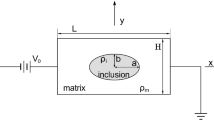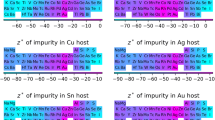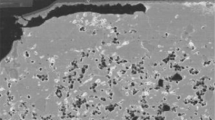Abstract
Microdefects that exist in interconnect lines, such as inclusions, undergo a complex morphological evolution due to electromigration, which poses a challenge to the reliability of the integrated circuit. The investigation of the morphological evolution for inclusions driven by electromigration can be beneficial to improve the performance of the integrated circuit, and the applicability of the nanopattern. In this paper, a phase-field model based on the Cahn–Hilliard equations with anisotropic interface diffusion is established and the corresponding finite-element program is developed to study the evolution of the inclusion in the {110}-oriented single crystal of face-centered-cubic interconnects under electromigration. The bulk free energy density and the degenerate mobility applied in the present model are both constructed by the quartic double-well potential function. The validation of the program is verified by comparing the theoretical solution and the numerical solution. The effects of the misorientation, the anisotropic strength, and the conductivity ratio on the morphological evolution of inclusions are emphasized in detail. The results indicate that the morphological evolution is dependent on the misorientation, the conductivity ratio, and the anisotropic strength. And there are three evolution modes of inclusions: steady-state migration, oscillation, and unstable splitting. Small misorientation or conductivity ratio favors the steady-state migration, while a larger misorientation or conductivity ratio results in the process of merging and splitting. And the frequency of oscillation depends on the misorientation and the conductivity ratio. The migration velocity of the steady state is determined by both the conductivity ratio and the anisotropic strength.





















Similar content being viewed by others
Change history
27 July 2022
A Correction to this paper has been published: https://doi.org/10.1007/s00339-022-05870-w
References
J.R. Lloyd, Electromigration and mechanical stress. Microelectron. Eng. 49, 51–64 (1999)
K.N. Tu, Recent advances on electromigration in very-large-scale-integration of interconnects. J. Appl. Phys. 94(9), 5451–5473 (2003)
L. Xia, A.F. Bower, Z. Suo et al., A finite element analysis of the motion and evolution of voids due to strain and electromigration induced surface diffusion. J. Mech. Phys. Solids. 45(9), 1473–1493 (1997)
E. Arzt, O. Kraft, W.D. Nix et al., Electromigration failure by shape change of voids in bamboo lines. J. Appl. Phys. 76(3), 1563–1571 (1994)
C.M. Tan, A. Roy, Electromigration in ULSI interconnects. Mater. Sci. Eng. R. Rep. 58(1), 1–75 (2007)
H. Ono, T. Nakano, T. Ohta, Diffusion barrier effects of transition metals for Cu/M/Si multilayers (M=Cr, Ti, Nb, Mo, Ta, W). Appl. Phys. Lett 64(12), 1511–1513 (1994)
M. Hayashi, S. Nakano, T. Wada, Dependence of copper interconnect electromigration phenomenon on barrier metal materials. Microelectron. Reliab. 43(9), 1545–1550 (2003)
C. Witt, C.A. Volkert, E. Arzt, Electromigration-induced Cu motion and precipitation in bamboo Al–Cu interconnects. Acta Mater. 51(1), 49–60 (2003)
Q. Ma, Z. Suo, Precipitate drifting and coarsening caused by electromigration. J. Appl. Phys. 74(9), 5457–5462 (1993)
H. Huntington, Electromigration in metals, ed. by A. S. Nowick, J. J. Burton (Elsevier, New York, 1975), pp. 303–352
F. Cacho, X. Federspiel, Modeling of electromigration phenomena, ed. by C. Kim, (Elsevier, Cambridgeshire, 2011), pp. 1–43
S. Strehle, J.W. Bartha, K. Wetzig, Electrical properties of electroplated Cu (Ag) thin films. Thin Solid Films 517(11), 3320–3325 (2009)
M. Schimschak, J. Krug, Electromigration-induced breakup of two-dimensional voids. Phys. Rev. Lett. 80(8), 1674–1677 (1998)
J. Cho, M.R. Gungor, D. Maroudas, Current-driven interactions between voids in metallic interconnect lines and their effects on line electrical resistance. Appl. Phys. Lett. 88(22), 221905 (2006)
M.R. Gungor, D. Maroudas, Theoretical analysis of electromigration-induced failure of metallic thin films due to transgranular void propagation. J. Appl. Phys. 85(4), 2233–2246 (1999)
J. Cho, M.R. Gungor, D. Maroudas, Theoretical analysis of current-driven interactions between voids in metallic thin films. J. Appl. Phys. 101(2), 023518 (2007)
J.J. Métois, J.C. Heyraud, A. Pimpinelli, Steady-state motion of silicon islands driven by a DC current. Surf. Sci. 420(2–3), 250–258 (1999)
C. Tao, W.G. Cullen, E.D. Williamst, Visualizing the electron scattering force in nanostructures. Science 328(5979), 736–740 (2010)
A. Kumar, D. Dasgupta, C. Dimitrakopoulos et al., Current-driven nanowire formation on surfaces of crystalline conducting substrates. Appl. Phys. Lett. 108(19), 211–243 (2016)
P.S. Ho, Motion of inclusion induced by a direct current and a temperature gradient. J. Appl. Phys. 41(1), 64–68 (1970)
W. Wang, Z. Suo, T.H. Hao, A simulation of electromigration-induced transgranular slits. J. Appl. Phys. 79(5), 2394–7403 (1996)
M. Schimschak, J. Krug, Surface electromigration as a moving boundary value problem. Phys. Rev. Lett. 78(2), 278–281 (1997)
T.H. Hao, Q.M. Li, Linear analysis of electromigration-induced void instability in Al-based interconnects. J. Appl. Phys. 83(2), 754–759 (1998)
J. Cho, M. Gungor, D. Maroudas, Electromigration-driven motion of morphologically stable voids in metallic thin films: Universal scaling of migration speed with void size. Appl. Phys. Lett. 85(12), 2214–2216 (2004)
Z. Li, N. Chen, Electromigration-driven motion of an elliptical inclusion. Appl. Phys. Lett. 93(5), 051908 (2008)
S.K. Lin, Y.C. Liu, S.J. Chiu et al., The electromigration effect revisited: non-uniform local tensile stress-driven diffusion. Sci. Rep. 7(1), 3082 (2007)
S.P. Riege, J.A. Prybyla, A.W. Hunt, Influence of microstructure on electromigration dynamics in submicron Al interconnects: real-time imaging. Appl. Phys. Lett. 69(16), 2367–2369 (1996)
M. Genut, Z. Li, C.L. Bauer et al., Characterization of the early stages of electromigration at grain boundary triple junctions. Appl. Phys. Lett. 58(21), 2354–2356 (1991)
T. Marieb, P. Flinn, J.C. Bravman et al., Observations of electromigration induced void nucleation and growth in polycrystalline and near-bamboo passivated Al lines. J. Appl. Phys. 78(2), 1026–1032 (1995)
O. Kraft, E. Arzt, Electromigration mechanisms in conductor lines: void shape changes and slit-like failure. Acta Mater. 45(4), 1599–1611 (1997)
A.V. Vairagar, S.G. Mhaisalkar, A. Krishnamoorthy et al., In situ observation of electromigration-induced void migration in dual-damascene Cu interconnect structures. Appl. Phys. Lett. 85(13), 2502–2504 (2004)
C.S. Hau-Riege, An introduction to Cu electromigration. Microelectron. Reliab. 44(2), 195–205 (2004)
A.W. Hunt, S.P. Riege, J.A. Prybyla, Healing processes in submicron Al interconnects after electromigration failure. Appl. Phys. Lett. 70(19), 2541–2543 (1997)
D.N. Bhate, A.F. Bower, A. Kumar, A phase field model for failure in interconnect lines due to coupled diffusion mechanisms. J. Mech. Phys. Solids. 50(10), 2057–2083 (2002)
J.W. Barrett, N. Robert, V. Styles, Finite element approximation of a phase field model for void electromigration. SIAM J. Appl. Math. 42(2), 738–772 (2004)
A.F. Bower, S. Shankar, A finite element model of electromigration induced void nucleation, growth and evolution in interconnects. Modell. Simul. Mater. Sci. Eng. 15(8), 923–940 (2007)
N. Singh, A.F. Bower, S. Shankar, A three-dimensional model of electromigration and stress-induced void nucleation in interconnect structures. Modell. Simul. Mater. Sci. Eng. 18(6), 065006 (2010)
T.O. Ogurtani, O. Akyildiz, Morphological evolution of voids by surface drift diffusion driven by the capillary, electromigration, and thermal-stress gradient induced by the steady state heat flow in passivated metallic thin films and flip-chip solder joints. II. Applications. J. Appl. Phys. 104(2), 59–78 (2008)
B. Sun, Z. Suo, A finite element method for simulating interface motion—II. Large shape change due to surface diffusion. Acta Mater. 45(12), 4953–4962 (1997)
D. He, P. Huang, A finite-element analysis of in-grain microcracks caused by surface diffusion induced by electromigration. Int. J. Solids Struct. 62, 248–255 (2015)
M. Mahadevan, R.M. Bradley, Simulations and theory of electromigration-induced slit formation in un-passivated single-crystal metal lines. Phys. Rev. B 59(16), 11037 (1999)
P. Kuhn, J. Krug, F, Hausser, et al., Complex shape evolution of electromigration-driven single-layer islands. Phys. Rev. Lett. 94(16), 166105 (2005)
D. Maroudas, Dynamics of transgranular voids in metallic thin films under electromigration conditions. Appl. Phys. Lett. 67(6), 798–800 (1995)
M.R. Gungor, D. Maroudas, Current-induced non-linear dynamics of voids in metallic thin films: morphological transition and surface wave propagation. Surf. Sci. 461(1–3), 550–556 (2000)
E.D. Koronaki, M.R. Gungor, C.I. Siettos et al., Current-induced wave propagation on surfaces of voids in metallic thin films with high symmetry of surface diffusional anisotropy. J. Appl. Phys. 107(7), 073506 (2007)
D. Dasgupta, D. Maroudas, Surface nanopatterning from current-driven assembly of single-layer epitaxial islands. Appl. Phys. Lett. 103(18), 181602 (2013)
D. Dasgupta, A. Kumar, D. Maroudas, Analysis of current-driven oscillatory dynamics of single-layer homoepitaxial islands on crystalline conducting substrates. Surf. Sci. 669, 25–33 (2018)
A. Kumar, D. Dasgupta, D. Maroudas, Complex pattern formation from current-driven dynamics of single-layer homoepitaxial islands on crystalline conducting substrates. Phys. Rev. Appl. 8(1), 014035 (2017)
J. Zhang, P. Huang, Phase field simulation of the void destabilization and splitting processes in interconnects under electromigration induced surface diffusion. Modell. Simul. Mater. Sci. Eng. 30(1), 015003 (2022)
Y. Li, X. Wang, Z. Li, The morphological evolution and migration of inclusions in thin-film interconnects under electric loading. Composites B 43(3), 1213–1217 (2012)
J. Santoki, A. Mukherjee, D. Schneider et al., Role of conductivity on the electromigration-induced morphological evolution of inclusions in {110}-oriented single crystal metallic thin films. J. Appl. Phys. 126(16), 165305 (2019)
J. Santoki, A. Mukherjee, D. Schneider et al., Effect of conductivity on the electromigration-induced morphological evolution of islands with high symmetries of surface diffusional anisotropy. J. Appl. Phys. 129(2), 025110 (2021)
M.E. Gurtin, Generalized Ginzburg-Landau and Cahn-Hilliard equations based on a microforce balance. Phys. D 92(3–4), 178–192 (1996)
J.W. Cahn, C.M. Elliott, A. Novick-Cohen, The Cahn–Hilliard equation with a concentration dependent mobility: motion by minus the Laplacian of the mean curvature[J]. Eur. J. Appl. Math. 7(3), 287–301 (1996)
C.L. Liu, J.M. Cohen, J.B. Adams et al., EAM study of surface self-diffusion of single adatoms of fcc metals Ni, Cu, Al, Ag, Au, Pd, and Pt. Surf. Sci. 253(1–3), 334–344 (1991)
C.L. Liu, Diffusion mechanisms at fcc metal surface-embedded atom method calculations. Int. J. Mod. Phys. B 9(1), 1–44 (1995)
D. Gaston, C. Newman, G. Hansen et al., MOOSE: a parallel computational framework for coupled systems of nonlinear equations. Nucl. Eng. Des. 239, 1768–1778 (2009)
T. Rabczuk, H. Ren, X. Zhuang, A nonlocal operator method for partial differential equations with application to electromagnetic waveguide problem. CMC. 59(1), 31–55 (2019)
H. Ren, X. Zhuang, T. Rabczuk., A higher order nonlocal operator method for solving partial differential equations. Comput. Methods Appl. Mech. Eng. 367, 113132 (2020)
H. Ren, X. Zhuang, N.T. Trung et al., Nonlocal operator method for the Cahn–Hilliard phase field model. Commun. Nonlinear. Sci. Numer. Simulat. 96, 105687 (2021)
N. Valizadeh, T. Rabczuk., Isogeometric analysis for phase-field models of geometric PDEs and high-order PDEs on stationary and evolving surfaces. Comput. Methods Appl. Mech. Eng. 351, 599–642 (2019)
T. Yu, J. Zhao., Semi-coupled resolved CFD-DEM simulation of powder-based selective laser melting for additive manufacturing. Comput. Methods Appl. Mech. Eng. 377, 113669 (2021)
N. Valizadeh, T. Rabczuk., Isogeometric analysis of hydrodynamics of vesicles using a monolithic phase-field approach. Comput. Methods Appl. Mech. Eng. 388, 114191 (2022)
P. Yue, C. Zhou, J. J. Feng., Spontaneous shrinkage of drops and mass conservation in phase-field simulations. J. Comput. Phys. 223(1), 1–9 (2007)
R. Almgren, Second-order phase field asymptotics for unequal conductivities. SIAM J. Appl. Math. 59(6), 2086–2107 (1999)
N. Moelans, B. Blanpain, P. Wollants, An introduction to phase-field modeling of microstructure evolution. Calphad 32(2), 268–294 (2008)
Acknowledgements
The work is supported by the Natural Science Foundation of Jiangsu Province of China under Grant No. BK20141407 and a Project Funded by the Priority Academic Program Development of Jiangsu Higher Education Institutions.
Author contributions
CD: methodology, software, validation, formal analysis, investigation, data curation, writing—original draft, and visualization. PH: conceptualization, resources, writing—review and editing, and supervision. JZ: methodology and software.
Author information
Authors and Affiliations
Corresponding author
Ethics declarations
Conflict of interest
The authors declare that they have no affiliations with or involvement in any organization or entity with any financial interest.
Additional information
Publisher's Note
Springer Nature remains neutral with regard to jurisdictional claims in published maps and institutional affiliations.
Rights and permissions
Springer Nature or its licensor holds exclusive rights to this article under a publishing agreement with the author(s) or other rightsholder(s); author self-archiving of the accepted manuscript version of this article is solely governed by the terms of such publishing agreement and applicable law.
About this article
Cite this article
Dong, C., Huang, P. & Zhang, J. Finite-element simulation of a phase-field model for inclusion electromigration in {110}-oriented single crystal metal interconnects due to interface diffusion anisotropy. Appl. Phys. A 128, 617 (2022). https://doi.org/10.1007/s00339-022-05754-z
Received:
Accepted:
Published:
DOI: https://doi.org/10.1007/s00339-022-05754-z




